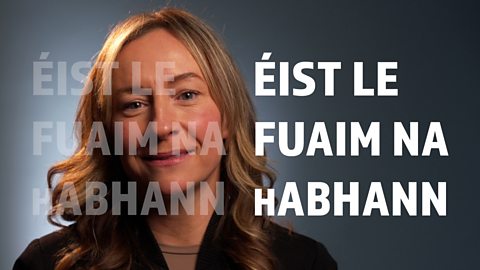Éist le Fuaim na hAbhann agus Gheobhaidh tú Breac

Éist le Fuaim na hAbhann agus Gheobhaidh tú Breac
Listen to the Sound of the River and You Will Get a Trout
Éist le Fuaim na hAbhann agus Gheobhaidh tú Breac
If you have a ‘cúpla focal’;
Listen to the sound of the river and you will catch a trout.
There are two clauses in this proverb each beginning with a verb. The first verb, ‘éist’ (listen) is the imperative form of the verb and is followed by the preposition ‘le’ which usually means with but in this case means to. The following phrase ‘fuaim na habhann’ begins with the noun ‘fuaim’ (sound) and is followed by ‘na habhann’ the genitive form of ‘an abhainn’ (the river). The genitive occurs here because it is qualifying the noun ‘fuaim’. The conjuction ‘agus’ (and) is followed by ‘gheobhaidh’, the future form of the verb ‘faigh’ (get) and the pronoun ‘tú’ (you) and finally the noun ‘breac’ (trout).
If you’re an advanced learner;
Éist le fuaim na habhann agus gheobhaidh tú breac
Listen to the sound of the river and you will catch a trout.
This proverb consists of two clauses connected by the conjunction ‘agus’ (and). The first clause begins with the phrase ‘éist le’ (listen to), the imperative form of the verb and the preposition’le’. The following noun ‘fuaim’ (sound) is a feminine noun which is indicated be the slender final consonant. ‘Na habhann’ consists of the genitive feminine form of the article ‘an’ which prefixes a ‘h’ to a followng initial consonant, ‘abhann’ > na habhann. ‘Abhainn’ is a feminine noun in the fifth conjugation (again indicated by the final slender consonant), which means its final consonant is broadened in the genitive case, abhainn > abhann. The genitive case occurs here because these words are qualifying the preceding noun ‘fuaim’.
‘Gheobhaidh tú’ is the future tense of the irregular verb ‘faigh’ (get) followed by the pronoun ‘tú’ you. ‘Breac’ (trout) is a masculine noun which is indicated by the broad final consonant, ‘breac’.
If you’re fluent but would like to improve your grammar;
Éist le fuaim na habhann agus gheobhaidh tú breac
Má éisteann tú go cúramach beidh rud éigin ar a shon agat.
Tugann an seanfhocal seo ceann eile inár gceann. ‘Is méanair don té a éisteann móráan agus a chanann beagán’, is fearr in amanna a bheith ag éisteacht agus gan bheith ag caint barraíocht.
I dtús an tseanfhocail tá an modh ordaitheach den bhriathar ‘éist’ a leanann an réamhfhocal ‘le’ é. Ina dhiaidh sin, táa an t-ainmfhocal baininscneach ‘fuaim’ againn cáilithe ag an tuiseal ghinideach ‘na habhann’ < ‘an abhainn’. Is ainmfhocal baininscneach é ‘abhainn’ sa chúigiú díochlaonadh a ndéantar leathnú ar a chonsan deireanach sa ghinideach. Cuireann ‘na’ an fhoirm bhaininsnceach den alt ‘an’ ‘h’ roimh ghuta atá i dtús an ainmfhocail a leanann é ‘an abhainn > na habhann.
Is é ‘gheobhaidh’ an aimsir fháistineach den bhriathar neamhrialta ‘faigh’.